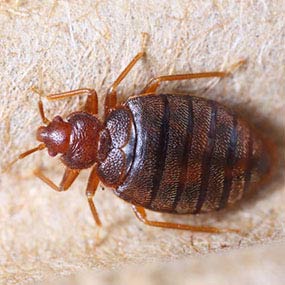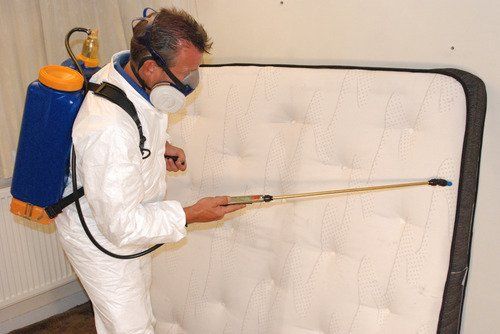How to Recognize Bed Bug Bites and Treat Them Quickly
How to Recognize Bed Bug Bites and Treat Them Quickly
Blog Article
Obtain Educated Regarding the Kinds of Parasite Control Methods and Their Benefits for Home Owners
Recognizing the numerous bug control techniques offered to home owners is essential for effective pest monitoring. House owners who are well-informed can make tactical choices that not only address bug problems but also boost the overall top quality of their living atmosphere.
Chemical Pest Control Methods
Chemical insect control techniques are a critical part of integrated bug administration methods for house owners looking for effective solutions to pest invasions. These methods involve the application of chemical substances made to get rid of or hinder parasites that endanger personal property, health and wellness, and convenience. Typical chemicals made use of include insecticides, herbicides, fungicides, and rodenticides, each tailored to target details pests.
The key benefit of chemical insect control is its rapid performance; lots of formulations offer instant results, lowering pest populaces dramatically in a short time. Furthermore, breakthroughs in chemical formulations have led to items that are much more eco-friendly and have reduced poisoning degrees for non-target microorganisms when used appropriately.

Biological Bug Control Techniques
All-natural parasite control approaches have gotten importance as house owners look for more secure and extra sustainable choices to standard chemical methods. Organic insect control techniques make use of all-natural predators, bloodsuckers, or pathogens to handle pest populations efficiently. This technique is not only environmentally friendly however additionally decreases the risk of injury to non-target species, including helpful insects and wild animals.
One of one of the most usual organic control techniques includes presenting all-natural killers into the environment. For instance, ladybugs can be used to control aphid populaces, while nematodes target soil-dwelling bugs like grubs. Additionally, parasitoids-- microorganisms that live on or within a host-- can be used to manage details bug species by laying eggs inside them, ultimately leading to their death.
One more approach is making use of biopesticides, which are acquired from all-natural materials such as minerals, plants, or germs (bed bug exterminator). These products can properly target parasites while presenting very little threat to pet dogs and humans. Generally, organic pest control techniques supply home owners with an effective means of parasite administration that straightens with environmental concepts, advertising a healthier living atmosphere while minimizing reliance on artificial chemicals
Mechanical Bug Control Strategies
Mechanical parasite control techniques encompass a range of techniques that physically stop or remove pests without the use of chemicals. These strategies are particularly advantageous for home owners seeking environmentally pleasant options while making certain the safety of their home.
One typical method is using obstacles, such as traps, nets, and screens, which avoid parasites from going into homes or particular areas. Mounting window screens can successfully keep pests out, while using physical barriers around gardens can discourage bigger bugs like deer or rabbits. In addition, mechanical traps created for rats can catch and get rid of these bugs without the requirement for hazardous materials.
Another reliable technique entails making use of mops and vacuums to get rid of bugs straight from surface areas. Regular cleaning and maintenance can substantially reduce bug populaces by eliminating food sources and hiding areas. Additionally, utilizing gadgets like ultrasonic bug repellents can hinder various bugs through acoustic wave that are unpleasant to them however Going Here inaudible to people.
Cultural Insect Control Practices
Social parasite control techniques concentrate on changing the setting and management methods to develop conditions that are less favorable to pest infestations. These techniques are fundamental in preserving a well balanced environment and reducing the dependence on chemical interventions. By changing farming practices, home owners can successfully hinder pests while advertising plant health.
One common approach consists of crop rotation, which interferes with the life cycles of pests by wikipedia reference changing the kinds of plants grown in a details location (bed bug exterminator). This not only lessens pest populations yet additionally boosts dirt health and wellness. In addition, intercropping-- planting varied plants in proximity-- can confuse parasites and minimize their ability to find their recommended host plants
Water management is one more essential aspect of cultural methods. Correct watering techniques can protect against standing water, which works as a reproduction ground for insects and other bugs. Preserving cleanliness in and around the home, such as on a regular basis removing particles and food waste, can significantly minimize parasite attraction.
Including these cultural techniques right into a detailed insect management approach enables property owners to develop an environment that naturally discourages parasites, therefore improving the effectiveness of various other control techniques while promoting lasting gardening and landscape design.

Integrated Parasite Monitoring Approaches
Integrated Insect Management (IPM) stands for an alternative method that incorporates different methods to successfully take care of insect populaces while lessening ecological influence. This technique incorporates organic, social, physical, and chemical methods to attain lasting pest control. By examining pest populations and their natural opponents, IPM highlights tracking and recognizing bugs before carrying out control actions.
Among the core principles of IPM is the usage of thresholds, which develop the degree of bug activity that requires intervention. This ensures that therapies are used only when required, minimizing the reliance on chemical pesticides. Biological control approaches, such as introducing all-natural wasp predators or parasites, operate in combination with cultural techniques like plant rotation and habitat adjustment to disrupt pest life cycles.
Moreover, IPM motivates the use of least-toxic chemical choices when treatment is needed, focusing on items that posture very little danger to non-target microorganisms and the setting. For property owners, adopting IPM approaches not only boosts the efficiency of insect monitoring however also advertises a much healthier living atmosphere, fostering biodiversity and lowering chemical exposure. Ultimately, IPM empowers home owners to make informed decisions that stabilize parasite control with ecological responsibility.
Final Thought
Finally, understanding the numerous parasite control techniques equips homeowners to make informed decisions relating to pest monitoring. Each approach-- chemical, biological, mechanical, cultural, and incorporated parasite management-- uses unique benefits that provide to different needs and choices. By selecting ideal methods, property owners can effectively take care of pest populations while minimizing wellness threats and ecological effects. This informed method adds to a healthier living atmosphere, advertising general health for animals and families alike.
Understanding the various bug control techniques offered to house owners is important for reliable parasite management.Chemical pest control approaches are a vital component of incorporated parasite monitoring methods for house owners looking for effective services to pest invasions. On the whole, biological parasite control methods supply home owners with an effective means of parasite management that aligns with eco-friendly concepts, advertising a healthier living setting while minimizing dependence on synthetic chemicals.
Cultural insect control techniques focus on customizing the atmosphere and monitoring techniques to create conditions that are much less favorable to pest invasions.In conclusion, understanding the different pest control methods encourages home owners to make informed choices regarding pest administration.
Report this page